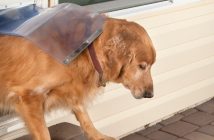When hurricanes threaten, we rush to stock up on water, charge our phones, and board up windows. But what about our pets? Too often, they’re an afterthought in the scramble to prepare.
Whether you live along the coast or inland where tropical systems can still bring dangerous flooding and power outages, having a plan for your pets is just as important as having one for yourself.
From knowing where you’ll go to packing the right gear, a little advance planning can make all the difference in keeping your furry family safe.
And when disaster strikes, the last thing you want to be doing is scrambling for a leash.
Hurricane Katrina displaced more than 100,000 pets, many left behind because shelters and rescue services wouldn’t take animals. That tragedy changed how we prepare.
The PETS Act, passed in 2006, now requires state and local emergency plans to include pets.
But even with new laws, disasters like Hurricanes Harvey and Ian revealed how panic and last-minute decisions still put animals at risk.
The takeaway? Don’t wait. Prepare now, and include your pets in your emergency plan.
1. Prep Your Hurricane Kit – Pets Included
During hurricane season, it’s smart to keep your household emergency supplies ready; things like flashlights, bottled water, and canned food. You may not have a full “go-bag” packed for yourself, but when an evacuation order hits, you’ll likely have time to toss together what you need.
Your pet, however, deserves a little more pre-planning.
Create a pet evacuation kit now, so you’re not scrambling to find leashes, vet records, or food in the middle of a stressful situation. Store it with your other emergency supplies or near the door so it’s easy to grab and go.
What to pack in your pet’s evacuation kit:
- Food and water for at least 7 days (in air-tight containers)
- Collapsible bowls
- Leash, harness, collar with pet tags
- All pets should be wearing an identification tag and collar
- Secure carrier
- Waste bags, litter supplies, paper towels, and wipes
- Any medications and/or supplements
- Comfort items like a toy, blanket, or something that smells like home
- A printed photo in case you get separated
- Copies of vet records, vaccine history, and microchip info
- Make sure vaccinations are up to date (rabies, kennel cough, etc.). Copies of vaccination certifications will be required by shelters
Label the container clearly and keep it in an easy-to-reach spot. Even if you end up sheltering in place, having these supplies ready will make life easier for both you and your furry family member.
And if you ever do need to use it, you’ll be glad it’s ready to go.
2. Know Where You’ll Go (and Whether They Allow Pets)
If a hurricane evacuation is ordered, the last thing you want to do is start googling pet-friendly places. Not all emergency shelters accept animals, and some hotels or evacuation centers may have strict pet policies. Waiting until the last minute to figure out where to go can be a dangerous gamble.
It is a good idea to identify a few evacuation sites and research potential pet accommodations in the area. Make a few calls now to check on the boarding policies of the local kennels or animal shelters and ensure you add any of their requirements to your emergency kit.
Take time now to identify:
- Pet-friendly evacuation shelters in your area (your local emergency management office or animal services department is a good place to start)
- Hotels along your evacuation routes that accept pets (websites like BringFido.com can help)
- Friends or family who live inland and would be willing to host you and your pet
It’s a good idea to keep a printed list of these options in your emergency kit. That way, even if the power or internet goes out, you’ll have backup options on hand.
Planning ahead gives you peace of mind and ensures you’re not forced into making a heartbreaking choice between your own safety and your pet’s.
3. Don’t Leave Pets Behind
It might seem safer to leave your pet at home during a hurricane, especially if they’re nervous travelers. But leaving pets behind is never the right choice.
Even if you leave extra food and water, storms are unpredictable. Floodwaters can rise quickly, power can be knocked out for days, and structural damage could trap or harm your pet. Emergency responders may not be able to reach them in time (or at all).
Your pet depends on you. If it’s not safe for you to stay, it’s not safe for them either. Make a firm family rule: if you evacuate, your pets evacuate with you. Their lives literally depend on it.
4. Prep Your Home If You Can’t Evacuate
Sometimes evacuation isn’t possible. Maybe it’s too late, roads are flooded, or the storm changed course quickly. If you’re sheltering in place, take steps to protect your pets just as you would yourself.
- Designate a safe room: Choose an interior room without windows, like a bathroom or laundry room, and bring your pets there during the storm.
- Keep them contained: Use crates or carriers for safety and comfort, especially if your pet is anxious.
- Stock supplies in advance: Have extra food, water, medications, and litter/potty supplies ready in your safe room.
- Secure windows and doors: Flying debris can be dangerous. Make sure all access points are reinforced or boarded up if possible.
You can’t predict the damage a hurricane will cause, but you can do your best to minimize you and your pet’s exposure to risk.
5. Keep Identification Up to Date
Hurricanes are chaotic. Even with the best preparation, pets can get separated from their families. One of the most important things you can do, before there’s ever a storm on the radar, is make sure your pet can be identified and returned to you.
- Microchip your pets: And make sure the information is current. A microchip is only useful if your phone number or address is up to date.
- Use ID tags: Every pet should wear a secure collar with tags that include your name and a reachable phone number.
- Consider a backup contact: Add the number of a trusted friend or family member outside of your immediate area in case you’re unreachable after the storm.
In disaster scenarios, shelters, vets, and animal rescues will check for chips and ID. A few simple updates now can make all the difference later.
6. After the Storm
Even after the hurricane has passed, the risks to your pets are not over. Storm damage, flooding, and power outages can create unsafe conditions for days or even weeks.
- Keep pets leashed or in carriers: Downed fences, debris, and unfamiliar smells can disorient even well-trained animals.
- Avoid contaminated water: Floodwater can contain bacteria, chemicals, and parasites that can make your pet sick.
- Watch for signs of stress or illness: Pets may experience anxiety, especially if routines were disrupted. Monitor eating, bathroom habits, and behavior.
- Reintroduce them to the home slowly: If you’ve evacuated, walk through the property first to check for hazards before letting pets explore.
Returning to normal takes time. Being cautious in the aftermath helps protect your pet’s health and emotional well-being.
Hurricane Prep for Pets: Quick Recap
Before hurricane season hits, make sure you’re ready with the essentials:
- A packed pet evacuation kit
- A confirmed, pet-friendly evacuation destination
- A solid backup plan if you can’t leave
- Up-to-date ID tags and microchip info
- Printed and digital photos of each pet
- An emergency contact list (vet, shelters, friends)
- Vaccination records and vet paperwork in a waterproof bag
- Favorite toys, treats, or blankets for comfort
- Leash, harness, or carrier for each pet
- Food, water, and medications for at least 3 to 7 days
Thinking ahead saves time, reduces stress, and protects your pets if things get chaotic.
No one wants to imagine facing a hurricane, but planning ahead can make all the difference. Pets rely on us completely, and having a plan in place helps keep them safe, calm, and cared for no matter what the storm brings.
Whether you end up evacuating or riding it out at home, your pets will be counting on you to be ready. Take a little time now to prepare!





2 Comments
It’s just good pet parenting to have a plan in place for the animals in the house as well as the people. Crates, food, water . . . these are all things that pet owners might have difficulty getting once a hurricane.
It must be really hard having to face such a calamity like the Hurricane Katrina. I also remembered how much devastation it had brought our country as well. It is such a relief as well that a lot of pet owners are preparing a pet kit in case certain emergencies arises.